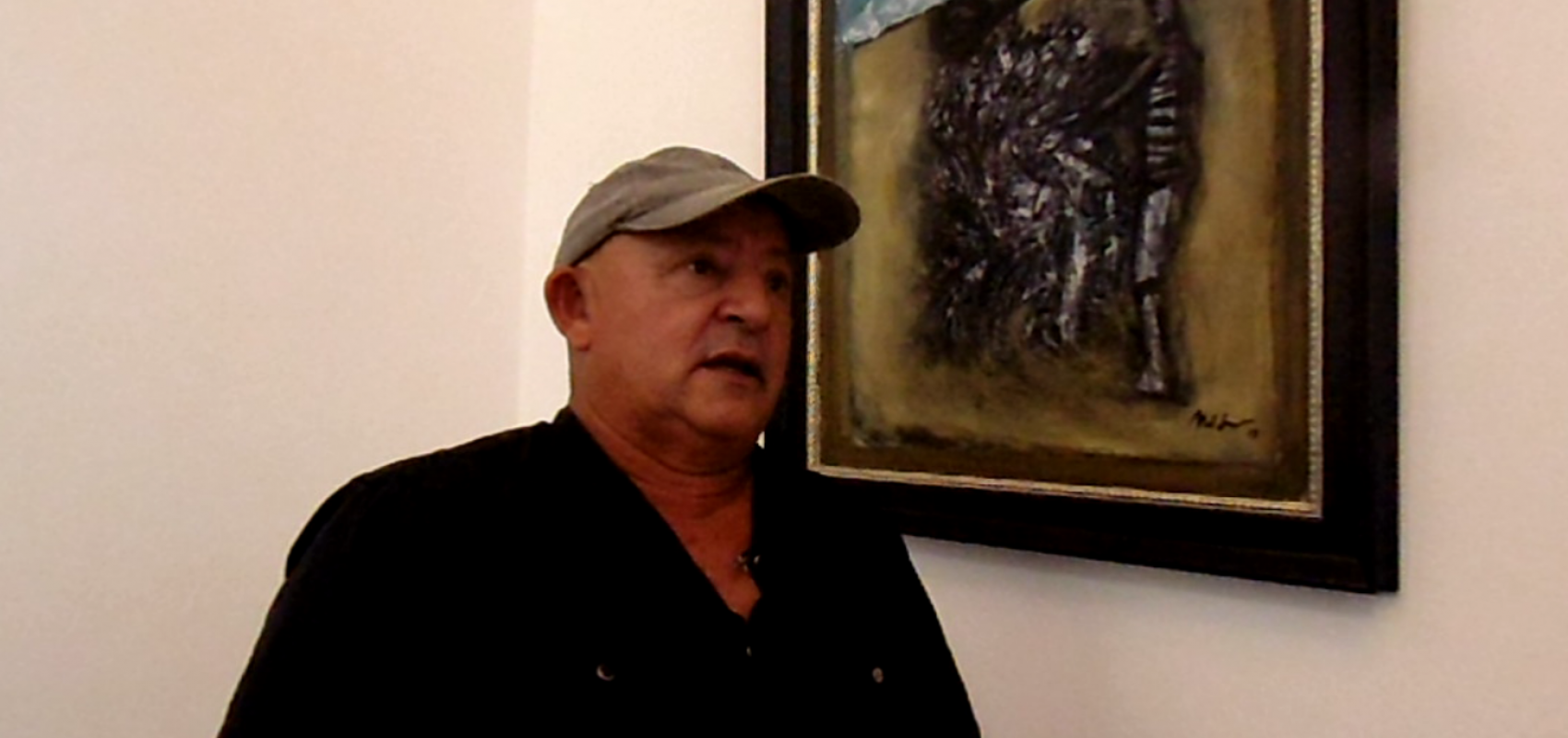Nelson Dominguez reached 73 years of age in 2020. Art, feeling, passion and daring mark the trajectory of the creator, winner of Cuba's National Plastic Arts Award in 2009, someone who has devoted himself to exploring pictorial paths and letting himself be trapped by doubt, when inspiration and the desire to leave a message on the canvas arrive, not only to delight the eye with portions of beauty, which is also important, but to exercise thought and generate analysis. For him, the most important thing is to make people think.
Just the day before celebrating his birthday, this September 23, Maxima opened its doors to interview the artist, one of the most pleasant moments in the midst of social confinement.
The early years of your life were marked by a strong contact with nature and animal life. How much is that reflected in your work?
Quite a lot. In the National Museum of Fine Arts (Cuban art building) there are works of mine such as Preludio de un rapto guajiro, A golpe de pilón, Rostros de agua y fuego and Verde amanecer, from my first pictorial period, which are very involved with the environment. One is part of where one lives, it is a synthetic description of the spaces one occupies in the universe.
The use of the color black in your works gives a certain drama and pictorial strength to the pieces. How do you conceive it?
The only place where black is not a color is in European painting, because in Asia, black is a color. That was my success in Japan and also in Asia, basically. What I am most is colorist, my color palette is what I want to do. If you notice, in a painting of mine there are almost all colors, but very managed, I hate black paintings.
A painting is not meant to be pretty, it is meant to say things and whoever likes a pretty painting should go elsewhere, in my studio he will not find it. You reminded me of Goya, who had Saturn devouring his son in the dining room of his house, and what does that have to do with it? If he wanted it that way... Maybe the painter is called to say things that an ordinary person, let's call him that, cannot say. It doesn't mean that he doesn't think about those things, but that he doesn't have the techniques or procedures to express messages. We, the painters, have that good possibility to say what we feel.
The painter must paint for himself first, I do it that way, and if he doesn't like it, let him go somewhere else. There are different colors for different tastes.
What messages do you express with your figuration?
You are asking me some difficult questions, a bit philosophical, and when you are about to turn 73, you go towards the simple, the elementary. They say that the most difficult thing is the elementary, because it implies an accumulation of experiences and facts.
Actually, I don't have topics that interest me in particular. My greatest passion will be at the end of the road, to look back and say: 'I learned to paint'. That's the most important thing. Painting. Then the messages you say are more personal. The message of a work can be different for different people, some give it a meaning, others interpret it differently.
Sometimes people reflect themselves in the work of others. That's why the titles of the paintings bother me a little, because it forces the viewer to think about what the artist wants. You have to leave an open space for thought.
Art is for thinking, people are used to you explaining and art is not explained. I'm not going to say when I die, because I'm not going to die, but when I'm gone, who are you going to explain the meaning of a work of art to? The pieces have their own reading and that reading is given by the person who sees it.
For years, you had a marital relationship with Flora Fong, how much were you able to complement each other in art?
We had two children. I never dabbled in her painting. We came from an art school where there were critiques, meetings to analyze the works, and analysis has nothing to do with familiarity. It's one thing to sleep with a person and another to think the way you do.
I don't remember ever telling Liang or Li how to paint this or that, but it's always a case of cat and mouse, they are close to you and they see you, even if it's by osmosis, things are falling out. Flora and I have the best relationship in the world, she is a great person, artist and I love her very much.
The first years of the National School of Art were difficult for you. How did that creative evolution take place, until you were among the top students along with Pedro Pablo Oliva and Flora Fong?
I joined a group of students who were graduates of provincial art schools, and I came from Guajira with yarey, because I liked painting. In the first year I almost got kicked out, I had no performance, I was blank. In the second year I was less likely to be thrown out, and in the third year I began to find my own way, I understood many things.
While my friends watched movies and went to parties, I was in the bathroom of my mother's house, the only place where I could draw, the house was very small, I did the homework of Professor Abela, one of the great teachers I had. Then in the fifth year I was lucky enough to be among the first files. There was a call for bids from Antonia Eiriz to choose an assistant and she chose me. It was the most sensational thing that ever happened in my life.
I had to teach the group of Zaida del Río and Flavio Garciandía. That group were the first students I worked with as Antonia's assistant, who made me go to Juanelo every day to review the exercises we were going to give in class, to see if I had understood them well.
There is a very good book, I recommend it to anyone who studies art, Fundamentals of Design, by Gillam Scott. I thought I understood an exercise, sometimes I had to do it three times.
The most terrible part for me was when I had Antonia sitting in front of me and I was giving the classes, I wanted to die, I became pale, cold. To have that monster next to me, an upstart assisting the greatest artist of Cuban art. In that year I learned much more than in the whole career. I carry that with me, in addition to the thing of doubt, of saying I've come this far but I have to do more now, to improve myself, I have to deny myself and in that denial is where many people are afraid.
The greatest idol of painting for me is Picasso, can you imagine him with the Marlborough Gallery? He didn't even graduate from school, he was an irreverent guy, no one could put him in a straitjacket.
I have friends who tell me 'Nelson, I envy you', because you paint whatever you want (...). The economy has done a lot of damage to art, at the beginning we didn't understand how it was to sell a painting. I remember the first work I sold was to an art critic, Romualdo and his wife Yaquelin, for 100 Cuban pesos. Today I would like to know where that painting is.
And what was it like?
Small, painted on kraft paper, a woman with a flute. That disappeared, I don't know if a photograph exists.
What importance do you give to spaces like Maxima and El Oficio, among others, which are the dynamizers of art and culture in Old Havana?
They are necessary. In the end, the gallery owner replaces that character that was called patron of the arts. I'd like galleries to have that dynamic. Sometimes I say, why does a Cuban have to go all the way around to participate in an auction, why can't Cuban galleries represent the artist in auctions, it has to be a foreigner or a very shrewd and seasoned person who knows what he wants, why isn't there that kind of intention, that galleries send their artists to auctions?
I don't consider myself a gallery owner or that sort of thing, but I have helped many artists. For example, I've received personal invitations to participate in the Arco Fair in Madrid and I've sent a group of young people, because I've already been there. That's what galleries are for, not only to sell works, but to develop talents that in the future will be collaborators of the spaces themselves.
What dreams does Nelson Dominguez still have to materialize?
First of all, I didn't sleep very well yesterday, I have to materialize my dream today. I have an important task, I want to do a project in Cojímar called Casa Abierta (Open House), where I will show all my collections.
What do you have in your collections?
Paintings, works of other artists and mine, furniture, documents, historical, important, in short, many things. To enter you will have to pay, it will be a social project, in which the money will be given to the community, that is, for an old man who doesn't have a wheelchair or someone to take care of him. The idea is to make another asylum in Cojímar, but different, where people are involved in art.
See works by Nelson Dominguez in Maxima: http://www.maximacubart.com/autor/nelson-dom-nguez
Published 5/10/2020





